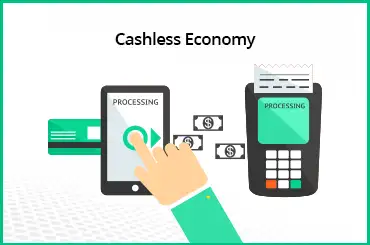As businesses continue to operate in the digital age, the creation of important documents such as invoices, purchase and sales orders, and quotations has become a daily occurrence. However, in cases where discrepancies arise, such as incorrect billing or damaged goods, the need for alterations in the accounting books and transactional documents like invoices is crucial. This is where understanding difference between credit note and debit note come in handy.
Take, for instance, the case of Mr. B, who mistakenly sold damaged goods worth Rs. 10,000 on a bill of Rs. 50,000. Instead of going through the cumbersome process of modifying invoices, he could have easily issued a credit note to the receiver, which is a more efficient and less time-consuming solution and saved resources by understanding debit memo vs credit memo.
With the introduction of GST rules, credit note and debit note in GST have become more important than ever, and it's essential for businesses to understand this process in detail and adopt automated tools that facilitate the creation of debit and credit notes.
In this blog post, we'll learn what is debit note in accounting, what is credit note in accounting , debit note vs. credit note, and debit note and credit note in GST with example. So, if you're an Indian business owner or accountant, read on to discover difference between debit note and credit note for your accounting process and help you avoid costly mistakes.
What Is A Debit Note?
A debit note is an instrument issued by the seller to the buyer to mark the transaction in the absence of an invoice, or to rectify the details of an already generated invoice to balance the books. Alternatively, a buyer can issue a debit note to indicate a debit balance on the seller's account wherein damaged, and bad-quality products are received.
Commonly used in B2B transactions, a debit note invoice, whenever issued, creates an additional tax liability; however, a supplementary invoice (debit note) will be treated as equivalent to a tax invoice in respect of payments. Moreover, it is mandatory for the parties involved in such a transaction to retain the records of the debit note GST input or output or supplementary invoice transaction till the expiry period of 72 months, from the date of filing of annual records related to such transaction. You can quickly create a debit note format in Excel for this.
What Is A Credit Note?
A credit note is an instrument issued by the seller to the buyer to write off a debt obligation for an invoice, either partially or wholly. You can easily create a credit note format in Excel.
A credit note invoice also acts as a declaration wherein, the issuer states that the account of the other party involved has been credited to the sender's book. Thus, the debited amount has been either reduced or written off entirely.
Moreover, as mandated by the GST norms, the records of a transaction completed via a credit note GST input or output have to be retained till the expiry of 72 months from the date of filing the annual return related to the transaction.
Difference Between a Debit Note and a Credit Note
Debit note and credit note in GST are primarily leveraged by businesses to rectify errors made during the generation of invoices or to balance the account in other possible scenarios, such as returns. Both terms may be confusing in some cases, so let's look at debit note vs. credit note and see their major differences:
| Basis of distinction | Debit Note | Credit Note |
|---|---|---|
| Meaning | A debit note format is used to reflect a debit on the account of another party thus involved in the transaction. The same may be issued when the buyer receives a lot of damaged goods and wants to return them because of quality concerns. | A credit note format is an instrument used to reflect credit on account of the other party thus involved in the transaction. The same may be issued by the seller to indicate the acceptance of a purchase return and to write off the debt obligation of the other party either partially or wholly. |
| Impact | Issuance of a debit note would reflect a reduction in the account receivable. | Contrary to this, issuing a credit note format under GST reflects a reduction in accounts payable. |
| Exchanged for | A debit note format is exchanged for a credit note. | A credit note format GST is exchanged for a debit note. |
| Reflects | On issuance of a debit note, it would reflect a positive amount. | On issuance of a credit note in GST, it would reflect a negative amount. |
| Tax Liability | In most cases, whenever a debit note is issued, it further increases the tax liabilities. This is a very important difference between credit note and debit note in GST. | In the case of issuance of a credit note format, you can reduce the output tax liability, if the return mentions transaction and other details correctly, in line with other documents. |
| Legal Perspective | A debit note is an instrument via which you can legally enhance the value of the goods sold or services rendered in the original tax invoice. It allows the supplier to pay the tax he is liable for without a complex process. | On the other hand, a credit note format under GST comes in handy when a supplier wishes to reduce his part of the tax liabilities by legally amending and revising the original tax invoices. |
When are Debit Note And Credit Note Issued?
Having understood debit note vs. credit note, let's look at the scenarios when one can issue the same:
When is a credit note issued?
A credit note format under GST is used in the following situations:
- You use credit note format GST when the value of goods declared by the supplier is way more than the actual value of the delivered goods.
- The tax amount levied on the goods is unusual, and not what is usually levied as per the GST norms on such categories of goods.
- The quantity delivered to the buyer was not as per the agreement.
- A credit note in GST is used when there is quality issues in the lot received by the party.
When is a debit note issued?
A debit note in GST is issued in the following situations:
- The value of the supplied goods or services is way less than their actual value.
- The tax levied on goods delivery is below the usually charged amount on such categories.
- You use debit note in GST when the buyer has received a quantity that is more than the agreement.
What Are The Details To Be Included In Debit Note And Credit Note?
There are several details to be mandatorily included in a debit note and credit note format. Following is the list you can follow:
- You must mention the supplier's name, address, and GSTIN number.
- The nature of the document, i.e., whether it is a credit or a debit note, should be mentioned.
- A serial number has to be given to the issued instrument, which shall not exceed 16 characters and should be unique to the financial year in which it has been generated.
- The instrument must also have the date of issuance of the document along with the receiver's name, address, and GSTIN number.
- Details regarding the receiver's address, name, address of the consignment delivery, state name, and code to be added.
- The value of the consignment shall be disclosed clearly, along with the details regarding the tax levied.
- Signature of the person thus issuing the instrument.
Debit Note Format Under GST
One must keep in mind a few things before generating a debit note format under GST to ensure due compliance during legal and financial audits; the following is a format you can follow:
- Mention clearly, the name and nature of the instrument
- The supplier's name, address, and GSTIN in debit note format under GST
- A serial number, less than 16 characters, specific to the financial year
- The date of issuance
- The serial number and date of the invoice for which you have issued the debit note format GST
- Name, address, and GSTIN (registered buyer), or name, address, address of delivery with state and pincode (non-GST registered buyers)
- The debit note must indicate the price of the consignment along with the tax and other liabilities
- Finally, the issuing person must sign the instrument, or if the person is unavailable, it must be signed by the person in charge, in his place (digital signatures are also accepted and considered legal now)
Credit Note Format Under GST
The credit note and debit note format are similar in many ways. Let's have a look:
- It must necessarily entail the name and nature of the document
- The supplier's name, address, and GSTIN are also mandatory
- A serial number must be given to the note, specific to the financial year, which shall not exceed 16 characters
- The issuance date must be present
- Serial number and the date of tax invoice for which the credit note is being issued
- Name and address of the buyer plus the delivery address with state and pin code for an unregistered buyer
- Finally, it must mention the consignment's value and the tax levied
- The signature of the issuing person is also required, mandatorily, or it won't be accepted as evidence for legal purposes.
Automate Debit And Credit Notes With An Expert Tool
Credit note and debit note are two instruments that are essential for any business, considering how to streamline accounting and bookkeeping transactions and align them with everyday business transactions. Regular management of debit and credit notes can be a time-intensive task for all the departments involved in an SME manufacturing business. Why not automate the creation of such documents with a cloud-based business automation tool like TranZact?
TranZact digitizes all core functions for an SME including sales, purchase, inventory and production. With TranZact you can seamlessly create a debit note and credit note, in addition to many other important documents such as GST-compliant invoices, purchase and sales orders, quotations, challan and more. Users can also share these documents easily over WhatsApp and Emails for increased convenience.
In addition to expert documentation, TranZact also offers business intelligence and reporting functions. It provides a free sign-up with all base features free forever. Business owners can sign up, explore the tool and upgrade only when they are fully convinced of how valuable TranZact is for their business!
FAQs on Debit Note vs Credit Note
1. Who prepares credit note?
A credit note is issued by the seller, which reflects a credit applied to the other party's account.
2. Who prepares a debit note?
A debit note is used in multiple scenarios by the seller to mark a transaction that has not been cashed yet. Alternatively, it can be issued by the buyer in cases where damaged goods are received.
3. What is the difference between a refund and a credit note?
Refunds and credit notes are two common ways for businesses to handle returns and cancellations, but they work differently. A refund is a payment returned to the customer's account, while a credit note is a document of proof stating its monetary value and could be used for future purchases.
4. How Does a Credit Memo Affect Accounts Receivable?
A credit memo is a document that reduces the amount owed by a customer. It can be issued for various reasons, such as returns, discounts, or errors. When a credit memo is issued, it affects the customer's account balance, reducing the amount they owe. This, in turn, affects the accounts receivable balance, which represents the total amount owed to a business by its customers.
















